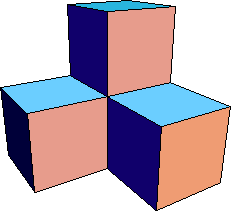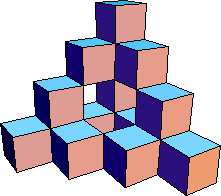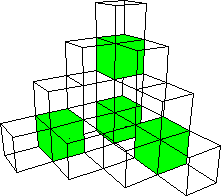We estimate the area of the limiting shape by finding the area of each stage in the
construction, and finding the limit.
| Continuing in this way, the second stage of the construction consists of 64
cubes, each with side length 1/4. |
| Each cube has 6 faces, each of area (1/4)2. |
| So the area is |
A2 = 4*(4*(4*6*(1/4)2 - 6*(1/4)2)
- 6*(1/4)2) - 6*(1/4)2 |
= 6*43*(1/4)2 - 6*(1/4)2*(1 + 4 + 42) |
| Following this pattern, we see |
An = 6*4n+1*(1/4)n -
6*(1/4)n*(1 + 4 + 42 + ... + 4n) |
= 6*4n+1*(1/4)n - 6*(1/4)n*((1 - 4n+1)/(1 - 4)) |
= 6*4 + (6/3)(1/4)n - (6/3)(1/4)n4n+1 |
|
| So An -> 16 as n -> infinity. |
| This is an upper bound for the area of the limiting shape. Unfortunately,
we cannot conclude that the area of the limiting shape is 16, because of a
well-known example. |






